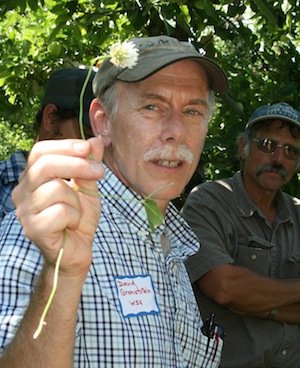
Kura clover was the winner in a cover-crop trial that WSU’s David Granatstein conducted with Warren Morgan Orchards.
Kura clover was one of four legume crops planted in the alleys in a trial that began at Warren Morgan Orchards in Quincy, Washington, in 2008. The objective was to grow a source of nitrogen in the alleys in an established apple orchard that could be mowed and blown into the tree row to supply part of the orchard’s nitrogen requirement. The other plants in the trial were ladino white clover, birdsfoot trefoil, and alfalfa. Perennial plants were selected to avoid the need to replant each year.
Participants in a recent tour organized by Tilth Producers of Washington and Washington State University’s Small Farms Program viewed the original planting as well as a grafted orchard block that had half the alleys seeded to alfalfa and half to white clover in 2010, based on initial results.
Seeds were planted into existing vegetation with a no-till drill. David Granatstein, with WSU’s Center for Sustaining Agriculture and Natural Resources, who is conducting the study in cooperation with the orchard, said the drill was not designed with orchards in mind, but it allowed the cover crop to be established without ripping out the grass, depleting soil organic matter, germinating weeds, and creating dust, which tends to incite mite problems. “This was a wonderful solution,” he said.
A four-foot strip in the middle of each alley was treated first with glyphosate or a burndown herbicide, and part was left untreated to see how the legumes would compete with the grass.
All four legumes established well. They did somewhat better where herbicide had been used. Each year, the legumes were mowed and blown onto the tree rows four times during the growing season. This was done with a rotary mower with side discharge.
Ladino clover
During a farm walk at the orchard this summer organized by Tilth Producers of Washington and WSU, Granatstein explained that for the first two years of the trial, the ladino clover looked promising, providing complete ground cover and quick regrowth. By the third year, it had largely died out. This happened as well in the grafted block, where deficit irrigation in year two may have been a factor. Granatstein chose white clover for the trial, because it often appears in orchards on its own and thus has some level of adaptation to the orchard environment. He selected the jumbo ladino variety to produce more biomass. A big concern with white clover is its attractiveness for voles.
Kura clover
Growth of the kura clover, which spreads by rhizomes, started out slowly, but improved each year. After five years, it is now the best looking of the cover crops and keeps getting stronger. “To me, this is a success. But can you wait that long? That’s the question,” Granatstein said, noting that more research needs to be done on how to get it established.
Alfalfa
The alfalfa also grew well at first. “One and a half months after it was planted, it looked like a hay field,” Granatstein told the group at the farm walk, referring to the planting in the grafted block where there was plenty of sunlight. The alfalfa was a grazer variety that was recommended for better longevity and regrowth. There are newer varieties specifically bred to withstand compaction from tractors, and this would be a useful trait. There are also spreading types similar to the kura clover. In the original trial, alfalfa was the winner for the first three years in terms of biomass and nitrogen but, over time, the stand has become thinner and thinner, and grass and dandelions have come in. Granatstein pointed out that there is bare ground under the alfalfa and said his theory is that the alfalfa grew erect and didn’t branch because of the low light level between the tree rows. Normally, alfalfa would be a solid mass.
He thinks that in this situation alfalfa and either the white clover or kura clover could have been planted together and, because of their different structures, the two types of plants might both have done well. The clover would have kept out weeds and contributed to the biomass.
Although dandelions are a problem because they can shorten the life of an alfalfa stand, a mixture of legumes and grass might not be a bad thing, Granatstein said.
The nodules on the roots of the legumes take nitrogen from the air and fix it into the plant, then that nitrogen is moved onto the tree row when the plant is mowed. The grass roots take up available nitrogen, keeping soil levels low which encourages the legume to fix more nitrogen. For this reason, it is theoretically possible to fix more nitrogen with a mixture of grass and legumes than a straight stand of legumes, he said.
Trefoil
The trefoil has gradually improved its stand over time, and its small yellow flowers are attractive to beneficial insects. Granatstein said it should continue to persist for several more years.

Leave A Comment